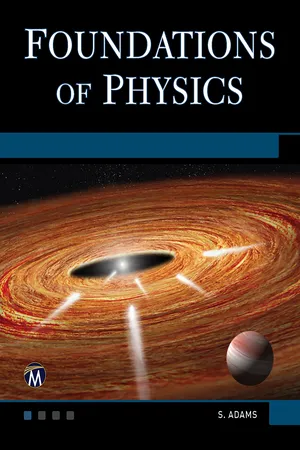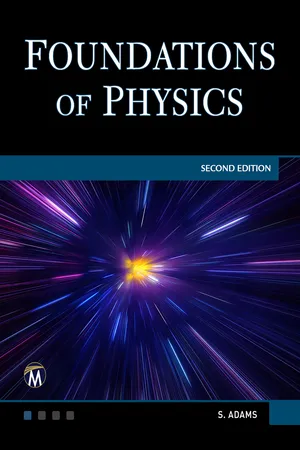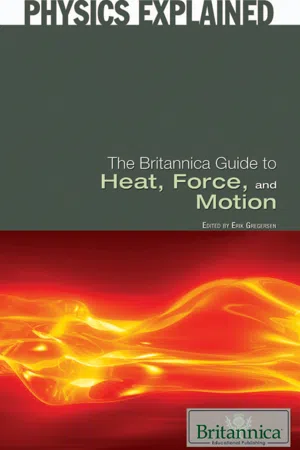Physics
Gravitational Field Strength
Gravitational field strength is a measure of the force exerted on a unit mass by a gravitational field. It is a vector quantity that is dependent on the mass and distance between two objects. The greater the mass and the closer the distance, the stronger the gravitational field strength.
Written by Perlego with AI-assistance
Related key terms
5 Key excerpts on "Gravitational Field Strength"
- eBook - ePub
- Steve Adams(Author)
- 2019(Publication Date)
- Mercury Learning and Information(Publisher)
23Gravitational Field23.1 Gravitational Forces and Gravitational Field StrengthGravity is one of the four fundamental forces. It has infinite range and obeys a similar inverse-square law to electrostatics. All masses create gravitational fields, but, unlike the electrostatic forces between charges, which can be attractive or repulsive, gravitational forces are always attractive. The gravitational force acting on a mass close to the surface of the Earth is called weight.Newton stated that two point masses would exert an attractive force on each other that is directly proportional to the product of the masses and inversely proportional to their separation. The minus sign indicates attraction.23.1.1 Newton’s Law of GravitationG is the universal constant of gravitation, G = 6.674 × 10−11 Nm2 kg−2 .Newton was also able to show that the force of attraction between spheres of uniform density is the same as the attraction between two point masses placed at their centers. This means that we can treat object like planets and stars as point masses when considering orbital motion. It is also important to note that, by Newton’s third law, the forces on each mass have the same magnitude, even if the masses are different. For example, the weight of an apple in the Earth’s gravitational field is the same as the weight of the Earth in the apple’s gravitational field. It is also the case that the gravitational force exerted on the Earth by the Moon is equal in magnitude to the gravitational force exerted on the Moon by the Earth.The resultant gravitational force on a body affected by the gravitational fields of several other objects (e.g., the Earth affected by the Sun, Moon, and other planets) is the vector sum of the gravitational forces from each of the other objects.23.1.2 Gravitational Field StrengthThe idea that gravitational forces arise from a gravitational field removes the difficulty of an action-at-a-distance explanation. The Moon is attracted to the earth because it experiences a force from the gravitational field where it is, i.e., a local force - eBook - ePub
- Steve Adams(Author)
- 2023(Publication Date)
- Mercury Learning and Information(Publisher)
23THE GRAVITATIONAL FIELD23.1 GRAVITATIONAL FORCES AND Gravitational Field StrengthGravity is one of the four fundamental forces. It has an infinite range and obeys a similar inverse-square law to electrostatics. All masses create gravitational fields but unlike the electrostatic forces between charges, which can be attractive or repulsive, gravitational forces are always attractive. The gravitational force acting on a mass close to the surface of the Earth is called weight.23.1.1 Newton’s Law of GravitationNewton stated that two-point masses would exert an attractive force on one another that is directly proportional to the product of the masses and inversely proportional to their separation. the minus sign indicates attraction.G is the universal constant of gravitation, G = 6.674 × 10− 11 Nm2 kg− 2 .Newton was also able to show that the force of attraction between spheres of uniform density is the same as the attraction between two point masses placed at their centers. This means that we can treat object like planets and stars as point masses when considering the orbital motion. It is also important to note that, by Newton’s third law, the forces on each mass have the same magnitude, even if the masses are different. For example, the weight of an apple in the Earth’s gravitational field is the same as the weight of the Earth in the apple’s gravitational field. It is also the case that the gravitational force exerted on the Earth by the Moon is equal in magnitude to the gravitational force exerted on the Moon by the Earth.The resultant gravitational force on a body affected by the gravitational fields of several other objects (e.g., the Earth affected by the Sun, Moon, and other planets) is the vector sum of the gravitational forces from each of the other objects.23.1.2 Gravitational Field StrengthThe idea that gravitational forces arise from a gravitational field removes the difficulty of an action-at-a-distance explanation. The Moon is attracted to the earth because it experiences a force from the gravitational field where it is - eBook - ePub
- Michael M. Mansfield, Colm O'Sullivan(Authors)
- 2020(Publication Date)
- Wiley(Publisher)
r.The Gravitational Field Strength functions for the special cases discussed so far are:uniform field: radial field due to a point mass M: For problems based on the material presented in this section visit up.ucc.ie/5/ and follow the link to the problems.5.3 The concept of flux
The gravitational force is just one example of a number of ‘inverse square law’ forces which arise in nature (we will meet further examples in Chapters 16 and 18 ). Whenever an inverse square law force is encountered, it turns out to be useful to introduce the concept of a flux. In such contexts, the concept is purely abstract but is adopted deliberately by analogy with examples of real fluxes that arise frequently in nature; for example, the flow of water from a garden hosepipe, the flow of light from an electric bulb, the flow of particles from a radioactive source, etc. It is conventional to define the total flux emanating from such a source as being equal to the strength of the source; for example, in the case of a light bulb the light flux can be measured in terms of the rate at which the bulb dissipates electrical energy, measured in watts. Other examples are given in Table 5.1Some examples of flux and flux densityTable 5.1Source Total flux from source Flux density at a point water hose litre per second litre s−1 m−2 light bulb watt watt m−2 radioactive source particles per second particles s−1 m−2 mass kilogram (*) kg m−2 (* ) (* ) Note: In this case the flux is entirely abstract.Gravitational flux density
The effect of a flux at a point some distance from its source can be described in terms of the flux per unit area in the neighbourhood of that point. As an example, consider a lawn being watered by a garden hose: the strength of the source, and hence the corresponding flux, may be considered as the volume of water per unit time emitted from the hosepipe. The effect at any point of the lawn (the amount of wetting) is determined by the volume per unit time per unit area landing at that point of the lawn. This latter measure is an example of a flux density (see the right hand column of Table 5.1 - eBook - ePub
- Hermann Weyl(Author)
- 2013(Publication Date)
- Dover Publications(Publisher)
The fact that a given gravitational field imparts the same acceleration to every mass that is brought into the field constitutes the real essence of the problem of gravitation. In the electrostatic field a slightly charged particle is acted on by the force e. E, the electric charge e depending only on the particle, and E, the electric intensity of field, depending only on the field. If no other forces are acting, this force imparts to the particle whose inertial mass is m an acceleration which is given by the fundamental equation of mechanics m b = e E. There is something fully analogous to this in the gravitational field. The force that acts on the particle is equal to g G, in which g, the “g ravitational char g e,” depends only on the particle, whereas G depends only on the field : the acceleration is determined here again by the equation m b = g G. The curious fact now manifests itself that the “g ravitational charge” or the “gravitational mass” g is equal to the “inertial mass” m. Eötvös has comparatively recently tested the accuracy of this law by actual experiments of the greatest refinement (vide note 3). The centrifugal force imparted to a body at the earth’s surface by the earth’s rotation is proportional to its inertial mass but its weight is proportional to its gravitational mass. The resultant of these two, the apparent weight, would have different directions for different bodies if gravitational and inertial mass were not proportional throughout. The absence of this difference of direction was demonstrated by Eotvos by means of the exceedingly sensitive instrument known as the torsion-balance : it enables the inertial mass of a body to be measured to the samedegree of accuracy as that to which its weight may be determined by the most sensitive balance - eBook - ePub
- Britannica Educational Publishing, Erik Gregersen(Authors)
- 2010(Publication Date)
- Britannica Educational Publishing(Publisher)
CHAPTER 11 GRAVITY : THE UNIVERSET he Newtonian theory of gravity is based on an assumed force acting between all pairs of bodies—i.e., an action at a distance. When a mass moves, the force acting on other masses had been considered to adjust instantaneously to the new location of the displaced mass. That, however, is inconsistent with special relativity, which is based on the axiom that all knowledge of distant events comes from electromagnetic signals. Physical quantities have to be defined in such a way that certain combinations of them—in particular, distance, time, mass, and momentum—are independent of choice of space-time coordinates. This theory, with the field theory of electrical and magnetic phenomena, has met such empirical success that most modern gravitational theories are constructed as field theories consistent with the principles of special relativity. In a field theory the gravitational force between bodies is formed by a two-step process: (1) One body produces a gravitational field that permeates all surrounding space but has weaker strength farther from its source. A second body in that space is then acted upon by this field and experiences a force. (2) The Newtonian force of reaction is then viewed as the response of the first body to the gravitational field produced by the second body, there being at all points in space a superposition of gravitational fields due to all the bodies in it.FIELD THEORIES OF GRAVITATION
In the 1970s the physicists Abdus Salam of Pakistan and Steven Weinberg and Sheldon L. Glashow of the United States were able to show that the electromagnetic forces and the weak force responsible for beta decay were different manifestations of the same basic interaction. That was the first successful unified field theory. Physicists are actively seeking other possible unified combinations. The possibility that gravitation might be linked with the other forces of nature in a unified theory of forces greatly increased interest in gravitational field theories during the 1970s and ’80s. Because the gravitational force is exceedingly weak compared with all others and because it seems to be independent of all physical properties except mass, the unification of gravitation with the other forces remains the most difficult to achieve. That challenge has provided a tremendous impetus to experimental investigations to determine whether there may be some failure of the apparent independence.
Index pages curate the most relevant extracts from our library of academic textbooks. They’ve been created using an in-house natural language model (NLM), each adding context and meaning to key research topics.




